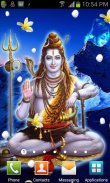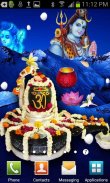





Lord SHIVA HQ Live Wallpaper

Descrição do Lord SHIVA HQ Live Wallpaper
May Lord Shiva Bless you on this Shivaratri
This is a beautiful high quality live wallpaper of God Shiva Shankar. It features Shivji, Parvati, Shivaling with shower of animated snow, flowers, diya and leaves.
Shivji is one of the trinity of gods in Hinduism, known as the Trimurthi. The three main gods are Vishnu, Brahma and Shivji. These gods represent, respectively, creation, maintenance and destruction. Shivji is also known as Shiva. The "ji" is added to the end of the name to designate respect. There are innumerable manifestations of Shivji. These forms arose at different stages in Indian history, and now form the mythology surrounding Lord Shiva.
Shiva is the god of the yogis, self-controlled and celibate, while at the same time a lover of his spouse (shakti). While of course many hindu deities are associated with different paths of yoga and meditation, in Shiva the art of meditation takes its most absolute form. In meditation, not only mind is stopped, everything is dropped. In deep meditation or samadhi, even the object of the meditation (like a mantra) is transformed into its formless essence, which is the essence of everything and everyone. Thus Shiva stands for letting go of everything in the world of forms. The path of Lord Shiva is the path of the ascetic yogi.
Shiva lingam is the holy symbol of Lord shiva that is considered quite sacred and worshipped with devotion by the devotees. The sanskrit word lingam means symbol, so shiva lingam means symbol of shiva. It is considered the foremost sacred symbol for shaivaites and has been worshiped for ages. The purANas like shiva mahA purANam discuss about the superiority of linga worship. Shivlinga stands for the union of Shiva / consciousness with Shakti/ energy and that is the cause of the cosmos.
Maha Shivratri, the night of the worship of Lord Shiva, occurs on the 14th night of the new moon during the dark half of the month of Phalguna. It falls on a moonless February night, when Hindus offer special prayer to the lord of destruction. Shivratri (Sanskrit 'ratri' = night) is the night when he is said to have performed the Tandava Nritya or the dance of primordial creation, preservation and destruction. The festival is observed for one day and one night only.
"Om Namah Shivaya!" - All through the day the devotees keep severe fast, chant the sacred Panchakshara mantra "Om Namah Shivaya", make offerings of flowers and incense to the Lord amidst ringing of temple bells. They maintain long vigils during the night, keeping awake to listen to stories, hymns and songs. The fast is broken only the next morning, after the nightlong worship. In Kashmir, the festival is held for 15 days. The 13th day is observed as a day of fast followed by a family feast.
Features:
1. High Quality Live wallpaper.
2. You can hide or unhide moving items, only background will be visible.
3. You can interact with moving items just touch to interact with them.
4. You can choose direction of moving items.
5. You can select speed of moving objects.
6. You can enable or disable interaction with moving objects.
7. You can also enable or disable hit counter in the background.
Please note free apps may contain ad which may support us to generate more free live wallpapers and applications for you. Thank you.
</div> <div jsname="WJz9Hc" style="display:none">Que o Senhor Shiva Deus te abençoe neste Shivaratri
Este é um belo papel de parede de alta qualidade ao vivo do Deus Shiva Shankar. Possui Shivji, Parvati, Shivaling com chuveiro de animação neve, flores, Diya e folhas.
Shivji é um dos trindade dos deuses, no hinduísmo, conhecida como a Trimurthi. Os três principais deuses são Vishnu, Brahma e Shivji. Esses deuses representam, respectivamente, a criação, manutenção e destruição. Shivji também é conhecido como Shiva. O "ji" é adicionado ao fim do nome para designar respeito. Existem inúmeras manifestações de Shivji. Estas formas surgiram em diferentes fases da história da Índia, e agora formam a mitologia em torno Lord Shiva.
Shiva é o deus dos iogues, auto-controlado e do celibato, enquanto ao mesmo tempo, um amante de seu esposo (shakti). Embora, naturalmente, muitas divindades hindus estão associados a diferentes caminhos de yoga e meditação, em Shiva a arte da meditação toma sua forma mais absoluta. Na meditação, não só mente está parado, tudo é descartado. Em profunda meditação ou samadhi, mesmo o objeto da meditação (como um mantra) é transformado em sua essência sem forma, que é a essência de tudo e de todos. Assim Shiva significa abrir mão de tudo no mundo das formas. O caminho do Senhor Shiva é o caminho do iogue asceta.
Shiva lingam é o símbolo sagrado do Deus Shiva, que é considerado muito sagrado e adorado com devoção pelos devotos. A palavra lingam sânscrito significa símbolo, assim shiva lingam significa símbolo de Shiva. É considerado o símbolo sagrado mais importante para Shaivaites e foi adorado durante séculos. Os purANas como Shiva Maha Puranam discutir sobre a superioridade de culto linga. Shivlinga significa a união de Shiva / Shakti com a consciência / energia e que é a causa do cosmos.
Maha Shivratri, na noite de adoração ao Senhor Shiva, ocorre na noite 14 da lua nova durante a metade escura do mês de Phalguna. Ela cai em uma noite sem lua de fevereiro, quando os hindus oferecer oração especial ao Senhor da destruição. Shivratri (sânscrito 'ratri' = noite) é a noite em que ele disse ter realizado o Tandava Nritya ou a dança de primordial da criação, preservação e destruição. O festival é observado por um dia e uma noite só.
"Om Namah Shivaya!" - Durante todo o dia os devotos manter jejum severo, entoar o mantra sagrado Panchakshara "Om Namah Shivaya", fazem oferendas de flores e incenso para o Senhor no meio de toque de sinos do templo. Eles mantêm longas vigílias durante a noite, manter-se acordado para ouvir histórias, hinos e cânticos. O jejum é quebrado apenas na manhã seguinte, após o culto nightlong. Na Caxemira, o festival é realizado durante 15 dias. O dia 13 é observado como um dia de jejum seguido de uma festa de família.
Características:
1 de alta qualidade ao vivo papel de parede.
2 Você pode ocultar ou reexibir itens em movimento, só o fundo será visível.
3 Você pode interagir com o movimento de itens apenas tocar para interagir com eles.
4 Você pode escolher direção de itens em movimento.
5 Você pode selecionar a velocidade de objetos em movimento.
6. Você pode ativar ou desativar a interação com objetos em movimento.
7 Você também pode ativar ou desativar o contador de visitas no fundo.
Por favor, note aplicativos gratuitos podem conter anúncios que podem nos apoiar para gerar mais papéis de parede ao vivo e aplicativos gratuitos para você. Obrigado.</div> <div class="show-more-end">



























